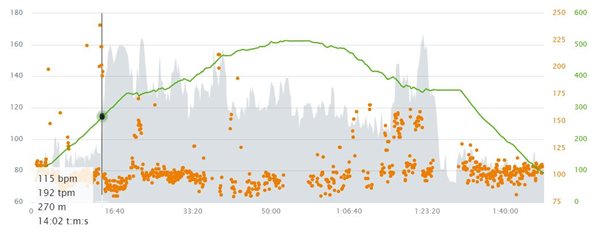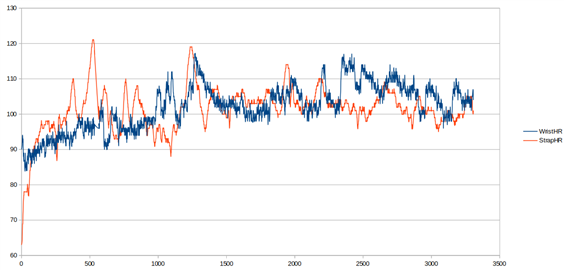I've done a few informal tests of the OHR accuracy on FR945 by running with a HR chest band and showing the OHR and the auxiliary HR on the same data screen.
When using the running and trail running activities and going at normal intensity and speed for those types of activity, the accuracy of the OHR is impressive. Mostly no more than 1-2 beats separate the OHR and the belt.
The results are far from that accuracy for other activities. I assume this is because Garmin put more work into the algorithms that estimate the HR based on the user's performance data, GPS speed and running cadence, for running activities. I also assume those algorithms don't just take the hardware reading and manipulate it, but actually makes the sensor look for a HR in a certain expected range. Any thoughts on that theory?
I'll focus on mountain hiking here, as it's a common activity for people who do multisport, trail and uphill races.
For a 1 to 10 hour mountain hike, the OHR is way too low most of the time, regardless of the activity type used (running/trail run/hiking). The tendency is that the OHR stays around 90-ish most of the time, while the real HR typically would go up and down, let's say between 80 and 170, as the gradient/climbs vary from almost flat to very steep.
- My theory is that the estimation algorithms applied, even when using the Hiking activity, are the same as those used for running, thus the low speed and cadence of a hiking person makes the watch expect a very low HR.
- Sometimes, while hiking, the watch will suddenly detect the correct HR and stay in the correct HR range for some time, before it goes back down to the low HR range it expects you to be in. This could be due to occasional increased speed or cadence as the trail goes downhill.
I believe the OHR on FR945 could perform much better for hiking, given improved algorithms that are applied only to hiking activities. These algorithms could take into account things like the current vertical speed and historical (5-minute) altitude change, while adjusting the significance of speed and severely reducing the effect of cadence as a factor in the calculation. It should be possible to make such an improvement with a software update for FR945.
Any thoughts on this, insights, comments? I'm sure many of you have discussed this before and maybe even contacted Garmin to request improvements.
I for one would greatly appreciate increased accuracy for hiking activities since they constitute a big part of my base training most of the year.




